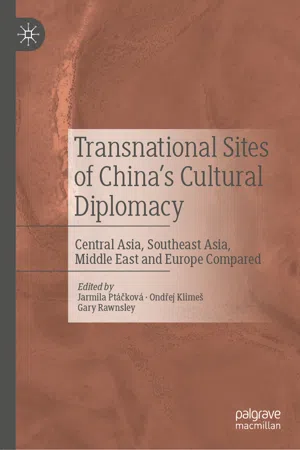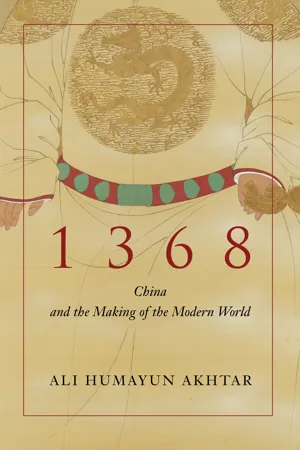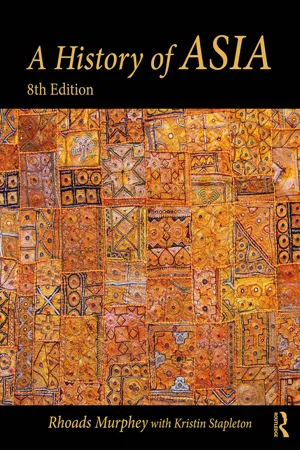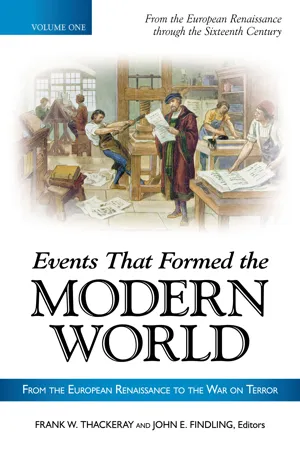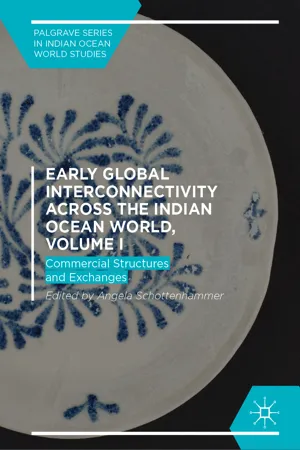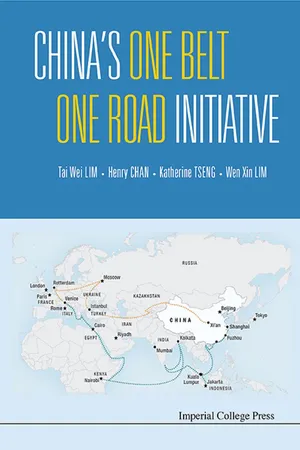History
Zheng He
Zheng He was a Chinese mariner, explorer, and diplomat who led seven major expeditions to the Indian Ocean and beyond during the early 15th century. He commanded a massive fleet of ships and is known for promoting trade, cultural exchange, and establishing diplomatic relations with various countries. Zheng He's voyages were significant in expanding China's influence and maritime power during the Ming Dynasty.
Written by Perlego with AI-assistance
Related key terms
Related key terms
1 of 4
Related key terms
1 of 3
6 Key excerpts on "Zheng He"
- eBook - ePub
Transnational Sites of China's Cultural Diplomacy
Central Asia, Southeast Asia, Middle East and Europe Compared
- Jarmila Ptáčková, Ondřej Klimeš, Gary Rawnsley, Jarmila Ptá?ková, Ond?ej Klimeš, Gary Rawnsley, Jarmila Ptá?ková, Ond?ej Klimeš, Jarmila Ptá?ková, Ond?ej Klimeš(Authors)
- 2020(Publication Date)
- Palgrave Macmillan(Publisher)
7 the official PRC narrative views and portrays the voyages in a very different light.First and foremost, Zheng He is celebrated as a navigator and explorer who ventured into the unknown, considerably expanding the horizons of mankind long before the European ‘age of discovery’ even began.8 But unlike the Western explorers, who, according to the PRC narrative, brought nothing but violence and exploitation, oppressing the peoples they encountered and colonizing their lands, Zheng He allegedly embarked on a peaceful mission of friendly and mutually beneficial cultural and commercial exchange which initiated the economic growth of the region.9 Zheng He is invoked as an envoy of peace—a harbinger of civilization introducing advanced technologies and spreading Chinese culture to the outside world (Li 2005 ). As such he has become a symbol of peaceful and harmonious cooperation within a larger community of shared interests and his maritime enterprise is presented as proof that China is a good neighbor whose peaceful rise to power should not be feared but embraced as an opportunity for further development.10The voyage of the Zheng He training ship and its stop in Malacca is but one example of the various diplomatic activities revolving around the figure of the Ming eunuch. Already in 2005 , when China celebrated the sexcentenary anniversary of Zheng He’s first voyage, the ministries of culture of the PRC and Malaysia co-organized a traveling exhibition, Envoy of Peace from China . Opened by the then Malaysian Prime Minister Badawi as part of official celebrations, the exhibition ‘highlighted the spirit of peace and friendship embodied in Zheng He and expressed China’s wish to carry out dialogue and exchanges with all other countries in the world’ (Malaysian PM 2005 - eBook - ePub
1368
China and the Making of the Modern World
- Ali Humayun Akhtar(Author)
- 2022(Publication Date)
- Stanford University Press(Publisher)
The admiral that led the expeditions, Zheng He of Yunnan, was a Muslim of part Bukharan ancestry. The crewmate who documented the expeditions, Ma Huan, was also Muslim. Their backgrounds reflected the global dimensions of Ming-era Chinese political culture, which was in continuity with China’s earlier Yuan (Mongol), Song, and Tang eras. Across all of these earlier centuries, inland cities like Xian and coastal cities like Quanzhou were centers of exchange that saw merchants from the Middle East and Central Asia come and go and, in many cases, settle permanently in Chinese cities. 1 Stories about Quanzhou circulated so widely in the Middle East in the medieval centuries that the city came to be known by an Arabic nickname: Zaytun (Italian: Zaiton). Against the backdrop of these earlier connections between China and its Middle Eastern trade partners, what Zheng He’s expeditions represented was a new projection across the South China Sea and Indian Ocean of Beijing’s global political and material culture. It was an image that the Ming sought to cultivate both locally and abroad—that is, across China’s overland and maritime frontiers in the worlds of Southeast Asia’s sultanates, Northeast Asia’s shogunates, Central Asia’s khanates, and an increasingly Ottoman-dominated Middle East. What made the timing of Zheng He’s expeditions impactful was the collapse in the previous century of Asia’s most influential empires and the rise of a litany of new states in the 1400s. In the lead-up to the European Age of Exploration, the most strategically located maritime states were the various sultanates close to the Spice Islands: the Sultanates of Melaka on the Malay peninsula, Brunei on the coast of Borneo close to Manila, Pasai on the northern tip of Sumatra, Bantam on the island of Java, and the like - eBook - ePub
- Rhoads Murphey, Kristin Stapleton(Authors)
- 2019(Publication Date)
- Routledge(Publisher)
A very different perspective on the Ming is provided by the Chosŏn Korean official Ch’oe Pu, who traveled through Ming territory under military escort after his boat was blown off course in 1488 and landed on the Chinese coast. Ch’oe was impressed by the efficiency of the Ming army, but appalled by the corruption of officials and what he considered the vulgarity of the people. As a good Chosŏn official, he despised the many Buddhists he encountered and was proud of his Confucian learning, which he thought exceeded that of any Chinese he met.MING MARITIME EXPEDITIONSWhat distinguished the early Ming, but fit the pattern of early Han, Tang, and Song, was the outreach of imperial pride, especially in the remarkable maritime expeditions begun during the reign of the Yongle emperor, Hongwu’s son. Using the nautical technology inherited from the Song, the eunuch admiral Zheng He mounted seven naval expeditions of Chinese fleets between 1405 and 1433, with up to 60 vessels. They toured much of Southeast Asia, the east and west coasts of India (including Calicut, where 90 years later Vasco da Gama was to make his Asian landfall), Ceylon, the Persian Gulf and the Straits of Hormuz, Aden, Jidda (from where seven Chinese went to Mecca), and East Africa. Some ships may have gone as far as the Cape of Good Hope or even around it. Despite recent claims, most scholars believe Zheng He’s fleet did not enter the Atlantic Ocean and certainly did not visit the Americas. They brought back giraffes, zebras, and ostriches to amaze the court and tributary agreements with gifts from a host of new states. When the king of Ceylon was considered not deferential enough, he was arrested and taken back to Nanjing, and Yongle appointed a new king in his place, but that intervention was very unusual.Zheng He’s many-decked ships carried not only up to five hundred troops but also cargoes of export goods, mainly silks and porcelains, and brought back foreign luxuries such as spices and tropical woods. The economic motive for these huge ventures was important, and many of the ships had large, private cabins for merchants. But another aim was political, to show the flag and command respect for the empire, as well as to enroll still more states as tributaries. - eBook - ePub
Events That Formed the Modern World
From the European Renaissance through the War on Terror [5 volumes]
- Frank W. Thackeray, John E. Findling, Frank W. Thackeray, John E. Findling, Frank W. Thackeray, John E. Findling(Authors)
- 2012(Publication Date)
- ABC-CLIO(Publisher)
Although it is sometimes overlooked, early Ming China enjoyed a long and successful maritime heritage dating back to at least the eleventh century. A vast, modern merchant marine traded extensively with Japan, Southeast Asia, and South Asia. Chinese goods, especially silks and porcelain, were in great demand. Large shipyards on the lower Yangtze River turned out both commercial and naval vessels. The Mongols had expanded the Chinese navy to coordinate it with their unequaled land forces; however, they suffered a crushing defeat when they tried to invade Japan in 1281. Nevertheless, at the beginning of the fifteenth century, China was the globe’s most important naval power. In terms of both size and technological achievement, the Chinese navy far surpassed anything that contemporary Europeans knew.China’s impressive naval strength caught the attention of the Yongle emperor, who had committed his realm to an active foreign policy on both land and sea. In 1403, the emperor ordered preparations for the first of seven voyages that over the next 30 years would take Chinese fleets to Sri Lanka, India, the Persian Gulf, Arabia, the east coast of Africa, and, perhaps, around the Cape of Good Hope.To superintend these voyages, the emperor chose Zheng He, today sometimes referred to as China’s Christopher Columbus. Zheng was born about 1371 in the southwestern province of Yunnan. His family was Muslim, and his father carried the honorary title of hajji, or one who had made the obligatory Muslim journey to Mecca. Quite possibly, Zheng was selected to head the voyages because his Muslim background and knowledge of Islamic customs would serve the Chinese fleet well as it traveled west to stop at Muslim ports of call.Zheng first made his mark at about age 20 when he helped suppress a rebellion in Yunnan against the prince of Yen. When Chu Ti became the Yongle emperor, he named Zheng to the prestigious post of Grand Eunuch of the Three Treasures and appointed him to head the naval expeditions. This was the first time in Chinese history that a eunuch had gained a command position over military forces. - eBook - ePub
Early Global Interconnectivity across the Indian Ocean World, Volume I
Commercial Structures and Exchanges
- Angela Schottenhammer, Angela Schottenhammer, Angela Schottenhammer(Authors)
- 2019(Publication Date)
- Palgrave Macmillan(Publisher)
China .True, the mid-Ming period witnessed a prominent moment in the history of Chinese maritime ventures. The seven voyages of Zheng He 鄭和 (1371–1433/35), supported by the third Ming emperor Yongle 永樂 (r. 1403–1424), marked an important phase in Chinese and world history, constituting the greatest maritime expeditions in premodern times, both in terms of scale and length of itineraries. The voyages were made possible by the continuous development of shipbuilding and navigational techniques and information about sea routes that had been accumulating in China for centuries. However, we should note that this was still a government-led project, and that private trades remained officially banned at the time of the expeditions. The voyages sought as their primary goal to make the states of the Indian Ocean acknowledge China ’s position, engaging them with the empire’s tribute system , although it brought some commercial advantages to China as well.50 In the long run, however, Chinese connections with Western Asia continued to diminish after the Zheng He ’s expeditions ended (following the death of the Yongle Emperor). The Mongols, after returning to Mongolia , continued to threaten the Ming dynasty, and so the Ming court found itself too busy with defending its northern borders to encourage further imperial ventures at sea. Throughout the remainder of the Ming dynasty, Chinese rulers took noticeably less interest in reaping the benefits of international maritime trade than earlier dynasties. While many individual Chinese advanced into Southeast Asia and actively engaged in international trade in the China Sea region as overseas Chinese (huaqiao 華僑), they confined their activities mainly to the Eastern Indian Ocean, having let go of their wider connections to the ocean’s western end.51 At the same time, contemporaneous sources like the Book of Min (Minshu 閩書) show that fewer merchants from countries in the Western Indian Ocean realm came to China ; instead, they went to the Philippines to conduct trade.52 - eBook - ePub
- Tai Wei Lim, Henry Hing Lee Chan;Katherine Hui-Yi Tseng;Wen Xin Lim(Authors)
- 2016(Publication Date)
- ICP(Publisher)
Section BThe History of Zheng He (Cheng Ho) and the Maritime Silk Road
Passage contains an image
Chapter 2
Introduction of the Overland Silk Road and Maritime Silk Road
TAN Ta SenIn September and October of 2013, the President of China, Xi Jinping, spelt out his vision of rebuilding economic belts along two ancient Silk Roads, the Northern Silk Road and the Southern Maritime Silk Road. In the context of the Maritime Silk Road, President Xi also mentioned the legendary voyages made by Cheng Ho (Zheng He in Hanyu Pinyin pronunciation) from China to East Africa in the 15th century. This prologue to the edited volume first brings you through an interesting historical journey of the two Silk Roads setting a stage for the appearance of the Ming dynasty Admiral Cheng Ho. His historic seven voyages fill the pages of the last part of this prologue giving the readers insights into the man himself, his voyages and its historical and contemporary significance in relation to today’s business opportunities and international relations.Zhang Qian’s expeditions to Central Asia
Zhang Qian, who was credited for opening up the Silk Road, was an official during the reign of Emperor Wu of the China’s Han Dynasty (206 BC–AD 220).During the Han dynasty, the Inner Asian steppe in Central Asia to the west of China known as the Western Regions by the Chinese, was dominated by nomadic Xiongnu tribes. In the late 3rd century, Xiongnu formed the first great confederation of nomadic tribes along China’s north and northwest borders. The Great Wall was built by Emperor Qin (Qinshi Huang) as a defense measure against them. However, Xiongnu continued to be a major threat to early Han emperors and prevented Han China from establishing economic relations with the Western Regions.In 138 BC, Emperor Wudi sent a mission led by Zhang Qian to the Yuezhi in modern-day Tajikistan with an aim to form an alliance against the Xiongnu. While traveling south of the Kunlun Mountains and crossing Qinghai, the group was captured by the Xiongnu and was put to hard labor. The courageous and devoted diplomat Zhang Qian married a native wife who bore him a son just to gain the trust of the Xiongnu king. Taking advantage of the internal power struggle within the Xiongnu tribe when the old king died in 126 BC, Zhang Qian and his men escaped but only three (Zhang Qian, his Xiongnu wife and the Xiongnu member of the mission) made it to the capital Changan (now Xian, Shaanxi province). During these 13 years abroad, he held on to his imperial insignia.
Index pages curate the most relevant extracts from our library of academic textbooks. They’ve been created using an in-house natural language model (NLM), each adding context and meaning to key research topics.
Explore more topic indexes
Explore more topic indexes
1 of 6
Explore more topic indexes
1 of 4
